 In this study, we characterized glacial meltwater flow through a proglacial area with a focus on proglacial lakes and their hydrological regime and connection to a stream. The studied lakes showed a distinct development throughout an ablation season. For example at Lake 2, the mean daily water-level fluctuation amplitude increased from 0.07 (June) to 0.18 m (August), then dropped to 0.07 m (September). Glacial meltwater flows through the lakes and further downstream through a rock glacier rather fast (0.085 m/s), however only a small portion of water (< 1%) is routed efficiently. The complexity of the site‘s drainage system is supported by varying isotopic composition of water in the tarns situated on the rock glacier, with Tarn a) being the most enriched and Tarn c) the most depleted in heavy isotopes. The results from this study site provide new insights into the complexity of a drainage system connecting a glacier and a stream. Further research of the tarns and subsurface water routing could bring new knowledge about the temperature-related degradation and internal changes of the rock glacier. Considered significant global water storage and influencing hydrological conditions of watersheds, these landforms will certainly draw more attention in near future.
In this study, we characterized glacial meltwater flow through a proglacial area with a focus on proglacial lakes and their hydrological regime and connection to a stream. The studied lakes showed a distinct development throughout an ablation season. For example at Lake 2, the mean daily water-level fluctuation amplitude increased from 0.07 (June) to 0.18 m (August), then dropped to 0.07 m (September). Glacial meltwater flows through the lakes and further downstream through a rock glacier rather fast (0.085 m/s), however only a small portion of water (< 1%) is routed efficiently. The complexity of the site‘s drainage system is supported by varying isotopic composition of water in the tarns situated on the rock glacier, with Tarn a) being the most enriched and Tarn c) the most depleted in heavy isotopes. The results from this study site provide new insights into the complexity of a drainage system connecting a glacier and a stream. Further research of the tarns and subsurface water routing could bring new knowledge about the temperature-related degradation and internal changes of the rock glacier. Considered significant global water storage and influencing hydrological conditions of watersheds, these landforms will certainly draw more attention in near future.
Falátková K., Šobr M., Slavík M., Bruthans J., Janský B. (2020): Hydrological characterization and connectivity of proglacial lakes to a stream, Adygine ice-debris complex, northern Tien Shan. Hydrological Sciences Journal 65, 610-623. (DOI)









 Cristian Quinones, geologist-geostatistician from Chile will stop in Prague during his lecture tour at European universities and will give a two-day workshop on “Practices for Mineral Resources Statement and Study Cases”. The course will take place on 26th and 27th March 2020 (9-17h) in Ložiskové sbírky room, Faculty of Science, Charles University, Albertov 6 building. Topics covered include International Codes, Audits, QAQC, Geological Models, Exploratory Data Analyses. For registration, see with one of the organizers, Dr. Jiří Zachariáš (
Cristian Quinones, geologist-geostatistician from Chile will stop in Prague during his lecture tour at European universities and will give a two-day workshop on “Practices for Mineral Resources Statement and Study Cases”. The course will take place on 26th and 27th March 2020 (9-17h) in Ložiskové sbírky room, Faculty of Science, Charles University, Albertov 6 building. Topics covered include International Codes, Audits, QAQC, Geological Models, Exploratory Data Analyses. For registration, see with one of the organizers, Dr. Jiří Zachariáš ( Mercury distribution in topsoils and vegetation samples and temperature-dependent Hg mobilization simulating wildfires have been investigated near a Cu smelter in semi-arid Namibia. The thermo-desorption experiments performed on the representative Hg-rich topsoils indicated that >91% of the Hg was released at ~340°C, which corresponds to the predominant grassland-fire conditions. Despite the installation of a sulfuric acid plant in the smelter in 2015 and a calculated drop in the estimated Hg emissions (from 1301 ± 457 kg/y for the period 2004-2015 to 67 ± 5 kg/y after 2015), the Hg legacy pool in the smelter surroundings will contribute to wildfire-driven Hg emissions until its complete burn-out. Using the Hg spatial distribution data in the area (184 km2), the estimates indicate that up to 303 kg and 1.3 kg can be remobilized from the topsoils and vegetation, respectively.
Mercury distribution in topsoils and vegetation samples and temperature-dependent Hg mobilization simulating wildfires have been investigated near a Cu smelter in semi-arid Namibia. The thermo-desorption experiments performed on the representative Hg-rich topsoils indicated that >91% of the Hg was released at ~340°C, which corresponds to the predominant grassland-fire conditions. Despite the installation of a sulfuric acid plant in the smelter in 2015 and a calculated drop in the estimated Hg emissions (from 1301 ± 457 kg/y for the period 2004-2015 to 67 ± 5 kg/y after 2015), the Hg legacy pool in the smelter surroundings will contribute to wildfire-driven Hg emissions until its complete burn-out. Using the Hg spatial distribution data in the area (184 km2), the estimates indicate that up to 303 kg and 1.3 kg can be remobilized from the topsoils and vegetation, respectively. Volcanic calderas are hazardous phenomena associated with cataclysmic eruptions that threaten surrounding nature, human society, and may also affect climate on a global scale. Active calderas are thus carefully monitored, however the underlying magma plumbing systems that store eruptible melt and feed ignimbrite eruptions are still poorly understood. In this paper, we have focused on the extinct Platoro caldera complex that erupted six large ignimbrite sheets between 30.2 Ma and 28.8 Ma in the Rocky Mountains (Colorado), and is associated with voluminous postcaldera intrusions. Using a multiparametric study (field mapping, petrography, radiometric dating, rock magnetism and anisotropy of magnetic susceptibility) of the Alamosa River pluton (29.0–27.3 Ma), we discovered an interesting behavior of magmatic activity that occurred after the main collapse episode. It has been documented that shallow-level magmatic systems of collapsed calderas remain active for another few millions of year, and produce multipulsed intrusions and complex dike swarms. Moreover, such intrusion are further distinguished as resurgent and postresurgent. The former induces ground deformation in form of uplifted domes, whereas the latter has no effect at the Earth´s surface.
Volcanic calderas are hazardous phenomena associated with cataclysmic eruptions that threaten surrounding nature, human society, and may also affect climate on a global scale. Active calderas are thus carefully monitored, however the underlying magma plumbing systems that store eruptible melt and feed ignimbrite eruptions are still poorly understood. In this paper, we have focused on the extinct Platoro caldera complex that erupted six large ignimbrite sheets between 30.2 Ma and 28.8 Ma in the Rocky Mountains (Colorado), and is associated with voluminous postcaldera intrusions. Using a multiparametric study (field mapping, petrography, radiometric dating, rock magnetism and anisotropy of magnetic susceptibility) of the Alamosa River pluton (29.0–27.3 Ma), we discovered an interesting behavior of magmatic activity that occurred after the main collapse episode. It has been documented that shallow-level magmatic systems of collapsed calderas remain active for another few millions of year, and produce multipulsed intrusions and complex dike swarms. Moreover, such intrusion are further distinguished as resurgent and postresurgent. The former induces ground deformation in form of uplifted domes, whereas the latter has no effect at the Earth´s surface. Karen Hudson-Edwards, Professor in Sustainable Mining at University of Exeter (UK), will give a lecture entitled „Environmental Minerals: Bacteria, Worms, Dusts, Toxins and the Human Body“ on Monday 13th January 2020 at 3 pm in Ložiskové sbírky (room no. 120, Albertov 6 building, Faculty of Science, Charles University). The lecture takes part of the European Association of Geochemistry Lecture Tour and is partly supported by Center for Geosphere Dynamics. You are cordially invited!
Karen Hudson-Edwards, Professor in Sustainable Mining at University of Exeter (UK), will give a lecture entitled „Environmental Minerals: Bacteria, Worms, Dusts, Toxins and the Human Body“ on Monday 13th January 2020 at 3 pm in Ložiskové sbírky (room no. 120, Albertov 6 building, Faculty of Science, Charles University). The lecture takes part of the European Association of Geochemistry Lecture Tour and is partly supported by Center for Geosphere Dynamics. You are cordially invited! This paper presented a new field method for measuring the depth of the vaporization plane below surface of porous materials. The measuring device consisting of a rod, adhesive, and a water-soluble dye is placed into a porous material. As the pore water dissolves the dye, thus changing the device’s appearance, the dry and wet zones inside of the material can be visually distinguished. The suggested method is minimally destructive as it can be used in holes as small as 2 mm in diameter, relatively fast (typical measurement takes 10 min), and cost-effective compared to other available methods. We have conducted >500 measurements on a range of compact materials (sandstone, arkose, tuff, rhyolite), mostly on natural outcrops in humid continental, warm and cold semi-arid, and desert climates. It has been also shown that the method can find use in studying water presence in building materials or soil. We believe the method will give the scientific community a whole new perspective of water distribution especially in the near sub-surface of porous rocks for studying salt and cavernous weathering, lithophilic organisms, or water dynamics in both natural and artificial porous materials.
This paper presented a new field method for measuring the depth of the vaporization plane below surface of porous materials. The measuring device consisting of a rod, adhesive, and a water-soluble dye is placed into a porous material. As the pore water dissolves the dye, thus changing the device’s appearance, the dry and wet zones inside of the material can be visually distinguished. The suggested method is minimally destructive as it can be used in holes as small as 2 mm in diameter, relatively fast (typical measurement takes 10 min), and cost-effective compared to other available methods. We have conducted >500 measurements on a range of compact materials (sandstone, arkose, tuff, rhyolite), mostly on natural outcrops in humid continental, warm and cold semi-arid, and desert climates. It has been also shown that the method can find use in studying water presence in building materials or soil. We believe the method will give the scientific community a whole new perspective of water distribution especially in the near sub-surface of porous rocks for studying salt and cavernous weathering, lithophilic organisms, or water dynamics in both natural and artificial porous materials. In 2019 a total of 50 papers have been published by the Center for Geosphere Dynamics in impacted journals (printed + in press). Papers published in the first and second quartile journals according to Web of Knowledge account for 92% of the total.
In 2019 a total of 50 papers have been published by the Center for Geosphere Dynamics in impacted journals (printed + in press). Papers published in the first and second quartile journals according to Web of Knowledge account for 92% of the total.
 The autumn meeting of the Center for Geosphere Dynamics will take place on Thursday November 7, 2019 at 2 pm in Ložiskové sbírky room, Albertov 6, Faculty of Science. Researchers and PhD students as well as other colleagues are cordially invited. Detailed program of the seminar is available
The autumn meeting of the Center for Geosphere Dynamics will take place on Thursday November 7, 2019 at 2 pm in Ložiskové sbírky room, Albertov 6, Faculty of Science. Researchers and PhD students as well as other colleagues are cordially invited. Detailed program of the seminar is available  Our investigation was situated in the natural geochemical arsenic anomaly at Smolotely-Líšnice Au district (Central Bohemia). Using the combination of geochemical (bulk soil and pore water analyses, selective chemical extractions, S isotopes), mineralogical (XRD, TEM, SEM/EDS) and biological (DNA extraction) methods we characterized massive accumulations of authigenic arsenic and iron sulfides (realgar, bonazziite, pyrite and greigite) on the fragments of organic matter that were buried in the shallow wetland soil. We have shown that by the development of suitable conditions of sulfidogenesis (very fast microbial sulfate reduction vs. slow transfer of solutes), fragments of organic matter may play an active role in arsenic immobilization in wetland systems.
Our investigation was situated in the natural geochemical arsenic anomaly at Smolotely-Líšnice Au district (Central Bohemia). Using the combination of geochemical (bulk soil and pore water analyses, selective chemical extractions, S isotopes), mineralogical (XRD, TEM, SEM/EDS) and biological (DNA extraction) methods we characterized massive accumulations of authigenic arsenic and iron sulfides (realgar, bonazziite, pyrite and greigite) on the fragments of organic matter that were buried in the shallow wetland soil. We have shown that by the development of suitable conditions of sulfidogenesis (very fast microbial sulfate reduction vs. slow transfer of solutes), fragments of organic matter may play an active role in arsenic immobilization in wetland systems.